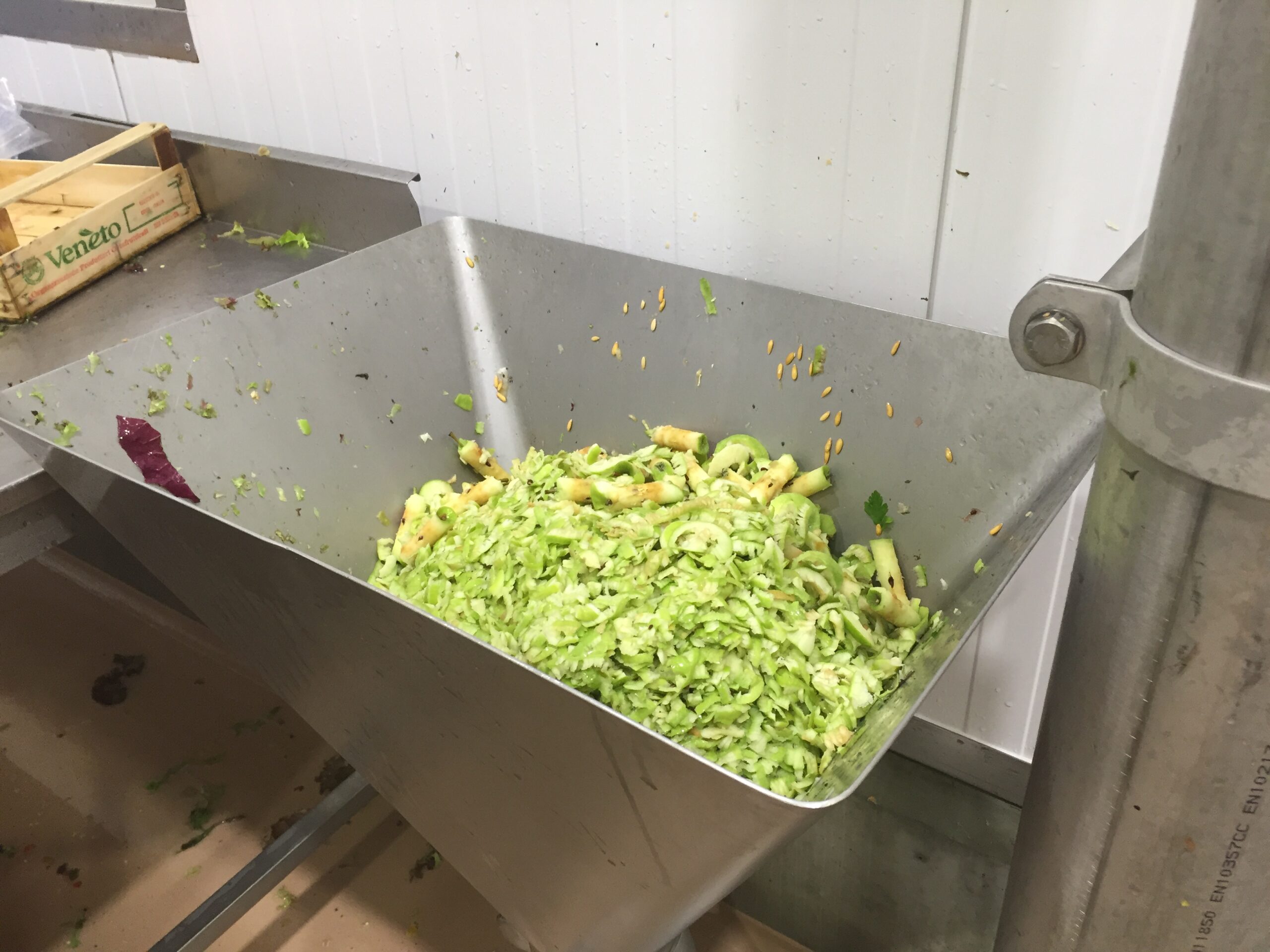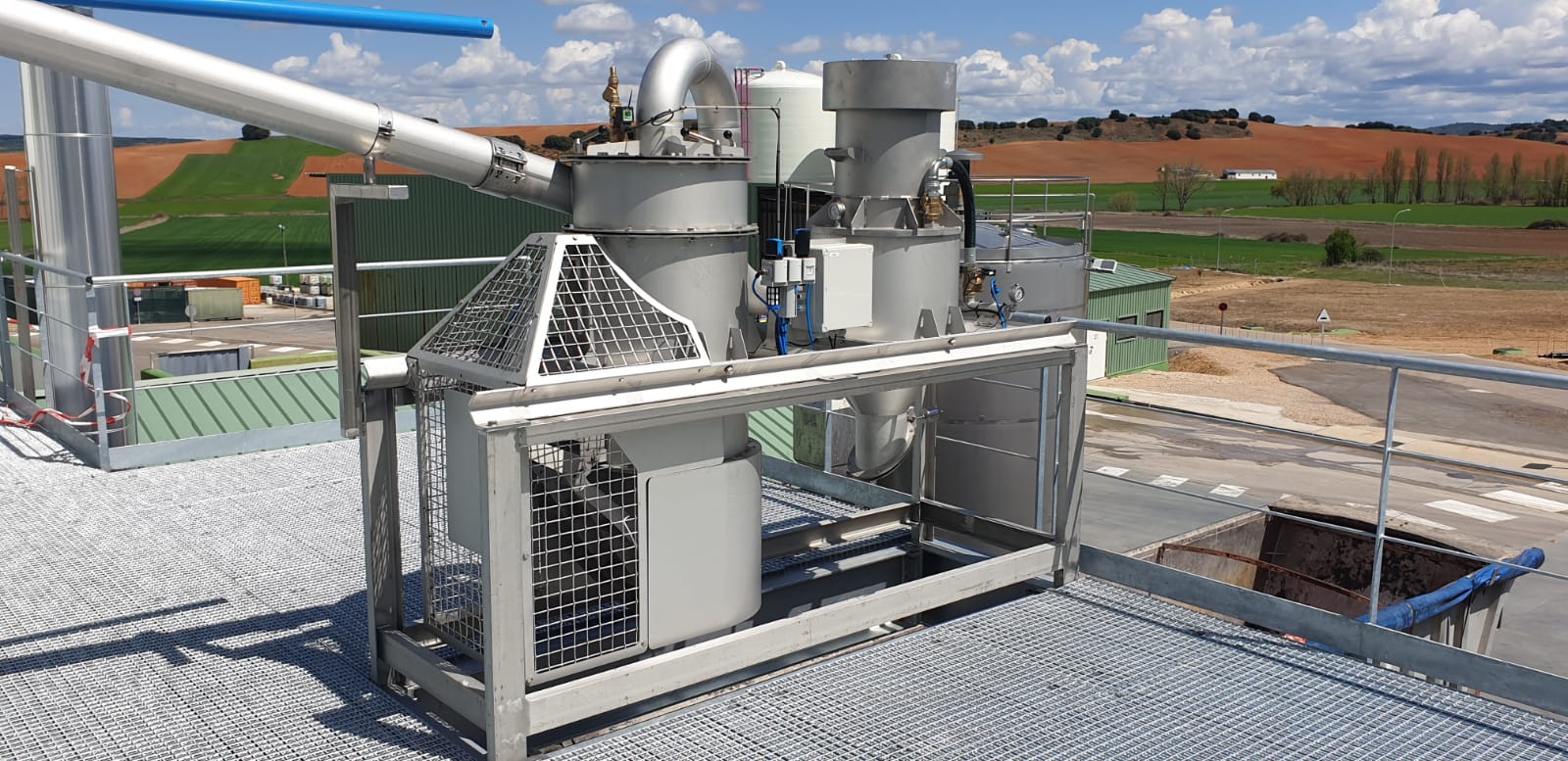Residual flows, through the ceiling, to the waste bin
After a long day of packing, cutting, shredding, pressing or de-coring fruit and vegetables, the next step is cleaning up. In many companies, this is still done in the old-fashioned way, with a high-pressure sprayer in which the waste on the floor is rinsed to a gutter. Or the residual products end up in a large waste bin in the production area that is emptied a few times a day by a forklift truck. But this can also be done above or below the ceiling. How? You can read about that below.
HYTT provides solutions for the transport of residual flows and by-products in industry by means of vacuum and a closed stainless steel tube system. «This tube system – comparable to, for example, the letter mail in a hospital or bank branch – offers numerous advantages on the shop floor,» says Eric Oving, recently director at the company from Borne in Twente. «The system works by means of a central vacuum generator to which you can connect various pipes and suction points, which transport the waste to a central container. The suction points are placed where the waste is generated to prevent unnecessary manual transport of waste. Take the example of a pineapple cutting plant. At the cutting table there is a funnel/extraction point where employees can throw in the peels of the pineapple. When the hopper is full, the HYTT system sucks the waste to a central container. Multiple extraction points can be connected to one system. One can also choose to transport each by-product to a different destination. The advantage of the system is that it is easy to build modularly, it is more hygienic and the waste can be separated quickly. On top of that, it is a lot more efficient because you either don’t need forklifts constantly driving from the production to waste site or you don’t need people manually pushing waste bins through the plant, even crossing high care zones, to the waste site.


One disadvantage that immediately comes to mind is a blockage in this pipe system but Eric remains level-headed about it. «In the five years that we have been supplying this system, we have not experienced this very often. Such problems are mainly caused by operating errors and can generally be located quickly in the pipe system. We also place removable pieces of pipe in crucial places for this purpose. For larger waste products we use a pipe with a larger diameter or we place a shredder at the extraction points, for example. Based on the more than 25 years of experience among our people, we know the risks and solutions.»
Going up in height
Eric points out that this system can also offer an advantage when it comes to saving space. «The HYTT system offers the advantage of being able to go up in height in your operation. So instead of a conveyor belt or forklift coming to pick up your products in the production hall, you can use the tubes, which have a diameter of about 15 centimeters, to go up in height and above or below the ceiling to dispose of your waste to a central container. In some cases, companies also have employees walking around taking away the waste manually with all the unnecessary hygiene problems that this entails. Risk factors are changing clothes when leaving the production area and pushing waste bins with your hands, after which fresh products are cut again. With the HYTT system, you can use these employees for other tasks and that will benefit labor productivity.»

Making money with your waste
Another benefit offered by HYTT’s closed pipe system is the valorization of waste streams. «The waste that goes into the pipe system has never been on the floor in the company. It goes directly into the hopper, through the tubes, to the waste container. In this way you can valorize these residual flows even better. Pineapple peels, for example, can be used to make juice, but it is important that they are kept separate and hygienic, which is possible with a separate tank for storing this waste. We see that the margins in the entire food industry are getting tighter and tighter and a valorization of residual flows can increase the margins. Many companies can make even more money if they do something with their waste, but then you have to process that waste in a hygienic and food-safe way.»
Hygiene
But what matters most about this system is hygiene. «With a water gutter system for waste, the chance of bacteria such as Listeria forming is a big problem. A large-scale study showed that of the 10,000 samples taken from floors and pits, Listeria was found in 40% of cases,» Eric says. «In addition, there is a high chance of cross-contamination if you are running around cleaning these gutters every day with high pressure because you are just pushing any contamination in front of you. By directly vacuuming your waste through a pipe system you no longer need these gutter systems for waste. A number of customers have also opted for a closed pipe system purely for hygienic reasons. A number of other customers have indicated that their customers, large fast food chains, wanted them to install such a system from an aesthetic point of view, the floors then remain free of waste and you are assured of a clean factory.»
Current events also show that HYTT’s pipe system can be a solution for reducing potential corona contamination. «Although these are just ancillary benefits, such a system can reduce the number of movements in a company because you no longer have anyone walking around having to take away the waste or come with their forklift to pick up the waste bins and bring them back.
Another solution HYTT has is to transport gloves, hairnets, aprons and mouth masks. Before or after the hygiene sluice, these wastes can be thrown into hoppers and everything is transported through a tube to the correct final destination. No hand contact with other people’s mouthguards and gloves. No dragging with large collection bags anymore.
We said it at the beginning of this article. Hygiene is the main reason for HYTT to have introduced this tube system to the market, because despite stricter requirements from foodservice and retail, according to Risk & Business, 109 recalls were recorded in the fruit and vegetable industry in the third quarter of 2019. (Risk & Business, Europe: in the third quarter 2019, beverage and food products again caused most recalls, 29-11-2019). For total Food & Beverage, the Netherlands ranked 4th in the number of recalls.
«The processing industry often points to the regulator for such recalls. Companies themselves also have a responsibility for good hygiene on the shop floor. For companies, the impact of such a recall is also difficult to calculate in their business operations. Both the damage to a company’s reputation and the importance of investing in hygiene are difficult to quantify. And yet it is in your best interest to avoid even the appearance of possible contamination. The valorization of residual flows helps somewhat in making these hygienic solutions transparent, because they can be determined in hard currency.»
«Imagine if a listeria bacteria is detected at your farm the consequences are huge,» Eric explains. «I don’t want to claim that this risk is 100 percent eliminated with such a pipe system but in this case the damage is limited to the residual stream and to the contents of the container. If the waste is disposed of in a large container or on a conveyor belt, the bacteria are spread around the plant and cause much more misery. The damage caused by a recall can run into millions, not to mention the damage to a company’s reputation. After all, it takes years to build a name but you can damage your reputation in seconds. The fact that there are special consultancies to help companies with such recalls does say something, of course.»

Futuristic tube systems
Closed pipes that can dispose of waste super-fast from multiple production halls from multiple companies to a central point on a business park. It conjured up something of a futuristic image of the factory of the future in which multiple companies will soon be processing their waste streams together at a single waste processing station on the industrial estate. «I hadn’t really thought about that,» Eric laughs. «That does seem to be an idea for the future, although we will have to see if that is possible with the power that such a vacuum pump can provide over longer distances. For the moment, we often offer our system in cooperation with machine builders because we are really complementary to the customer in this field of waste transport. So we still often install such a system next to the new processing machine for carrots or lettuce, for example. In addition, companies would then also have to agree among themselves on the joint processing of their waste and look at the extent to which they want to keep residual flows separate. So it sounds good, but it still has some way to go.»